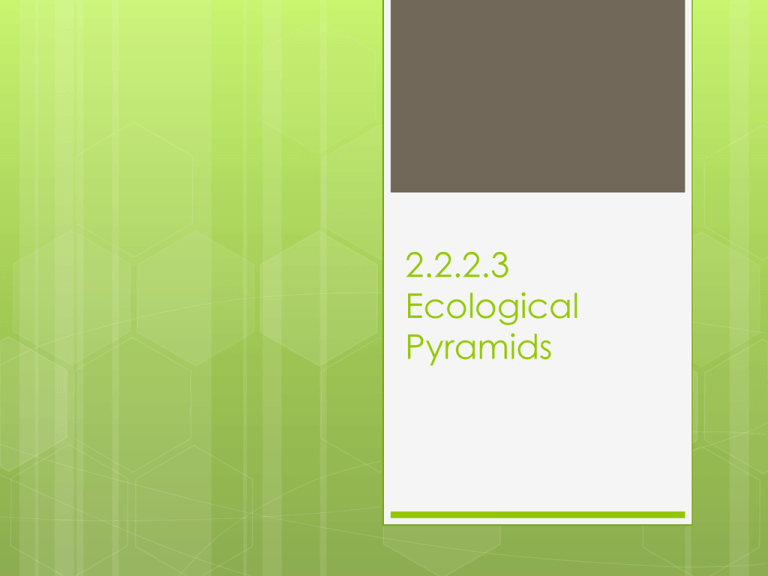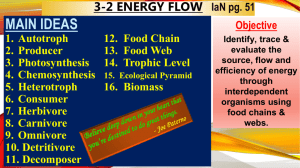2.2.2.3 Use of pyramid ppt - Amazing World of Science with Mr
advertisement

2.2.2.3 Ecological Pyramids Ecological Pyramids Ecological pyramids represent numerical relationships between successive trophic levels in a community. Which pyramid is chosen for examination depends on the type and quantity of data collected. Pyramids Graphic models of quantitative differences between trophic levels By second law of thermodynamics energy decreases along food webs Pyramids are thus narrower as one ascends Losses in the pyramid Energy is lost between each trophic level, so less remains for the next level Respiration, Homeostasis, Movement, Heat Mass is also lost at each level Waste, shedding, … Pyramids of Numbers One way to simplify food webs is to assign the organisms to trophic levels and then count the number of organisms in each trophic level. Pyramids of Numbers Needs sampling similar to Biomass and therefore has the same limitations Also measures the storages Pyramids of Numbers Represents the numbers of individual plants and animals present in the food web. It does not take into account the relative size of any organisms. Consequently, it is possible to have an inverted pyramid of numbers. © 2004 Brooks/Cole – Thomson Learning Pyramids of Numbers Grassland (summer) Tertiary consumers Secondary consumers Primary consumers Producers Temperate Forest (summer) Pyramids of Biomass A pyramid of biomass takes body size into account You have to find the dry mass of the organisms in your sample and their energy content (this must be measured in a fixed area). However, it does seem to be logical i.e. big organisms support lots of little ones. Pyramids of Biomass Represents the standing stock of each trophic level (in grams of biomass per unit area g / m2) Represent storages along with pyramids of numbers How do we get the biomass of a trophic level to make these pyramids? Why can’t we measure the biomass of an entire trophic level? Take quantitative samples – known area or volume Measure the whole habitat size Dry samples to remove water weight Take Dry mass for sample then extrapolate to entire trophic level How do we get the biomass of a trophic level to make these pyramids? Evaluation It is an estimate based on assumption that all individuals at that trophic level are the same The sample accurately represents the whole habitat Pyramids of Biomass Biomass decreases at each trophic level because the transfer of energy from the primary producer to the primary consumer and between the consumers is inefficient. Energy is lost at each stage, that is, at each of the transfers. Pyramids of Biomass See example on your sheet green plant zebra lion © 2004 Brooks/Cole – Thomson Learning Abandoned Field Pyramids of Biomass Tertiary consumers Secondary consumers Primary consumers Producers Ocean Pyramids of productivity Pyramids of productivity require much more data to construct since many samples, separated by intervals of time, are needed to estimate productivity, They provide a coherent view of how an ecosystem works. Pyramids of productivity Production by primary producers must be greater than production by secondary consumers and so on. Do not need to consider numbers or differences in size because all organisms can be converted to their energy equivalent. Pyramids of productivity Flow of energy through trophic levels Energy decreases along the food chain Lost as heat Productivity pyramids ALWAYS decrease as they go higher – 1st and 2nd laws of thermodynamics Pyramids of productivity Shows rate at which stock is generated at each level Productivity measured in units of flow (J / m2 yr or g / m2 yr ) © 2004 Brooks/Cole – Thomson Learning Energy Input: 1,700,000 kilocalories Incoming solar energy not harnessed 1,679,190 (98.8%) Energy Transfers Waste, remains 20,810 (1.2%) Producers 4,245 Metabolic heat, export 3,368 13,197 Herbivores Top carnivores 21 Carnivores Herbivores 383 3,368 720 383 2,265 Carnivores 90 21 Top carnivores 5 272 16 Decomposers, detritivores Energy Output Total Annual Energy Flow 20,810 + 1,679,190 1,700,000 (100%) Decomposers/detritivores Producers 20,810 5,060 Figure 54.11 An idealized pyramid of net production Figure 54.14 Food energy available to the human population at different trophic levels Efficiency of trophic levels in relation to the total energy available decreases with higher numbers But efficiency of transfer always remains around that 10% rule How does pyramid structure effect ecosystem function? Limited length of food chains 1. • • • Rarely more than 4 or 5 trophic levels Not enough energy left after 4-5 transfers to support organisms feeding high up Possible exception marine/aquatic systems b/c first few levels small and little structure How does pyramid structure effect ecosystem function? Vulnerability of top carnivores 2. • • • Effected by changes at all lower levels Small numbers to begin with Effected by pollutants & toxins passed through system



